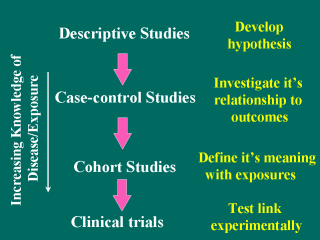 |
To further
illustrate, if one seeks to identify the etiologic factors (e.g. causal
factors) behind an outcome (e.g. an injury), then each step in the
epidemiologic framework provides new and important information.
Descriptive studies are useful for identifying hypotheses to test in
analytic studies. Case-control studies are then usually applied to evaluate
if the hypothesized factor is related to the outcome of interest.
Subsequently, cohort or longitudinal studies are applied to further define
the importance of exposure to the causal agent for the development of the
outcome.
|
